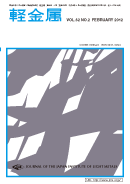All issues

Volume 62, Issue 2
Displaying 1-6 of 6 articles from this issue
- |<
- <
- 1
- >
- >|
RESEARCH REPORT
-
Manabu Takai, Yukihiro Sakamoto, Matsufumi TakayaArticle type: Research Report
2012Volume 62Issue 2 Pages 47-53
Published: February 28, 2012
Released on J-STAGE: March 30, 2012
JOURNAL FREE ACCESSMagnesium is a light metal with high specific strength and electromagnetic shielding properties. In recent years, it is required to adhere magnesium alloys with different metals. Bonding method is one of easy joint process between magnesium alloys and other materials. Contact corrosion of magnesium and different metals can be suppressed by using of adhesive. On the other hand, chromate conversion coating on magnesium was known as carcinogen and one of the methods to limit use of conversion coating. This paper describes the effects of conversion coatings on bond properties of magnesium and aluminum alloys. AZ31B magnesium alloy and A2017, A6022 aluminum alloys were used as specimens. Bond properties were evaluated by pull-off test, bond torque test and tensile lap-shear strength test. In addition, galvanic corrosion was evaluated by salt spray test. As a result of investigation on the bond strength of conversion coatings, the highest bond strength was obtained from the specimen of Mg(OH)2 coating on magnesium alloy and boehmite on aluminum alloy using epoxy resin for cure temperature of 373 K. The Mg(OH)2 coatingis expected as one of the alternatives of the chromate conversion coating.View full abstractDownload PDF (11254K) -
Jinuk Kim, Kazuto Okayasu, Hiroshi FukutomiArticle type: Research Report
2012Volume 62Issue 2 Pages 54-59
Published: February 28, 2012
Released on J-STAGE: March 30, 2012
JOURNAL FREE ACCESSThe formation behavior of textures during high temperature plane strain compression deformation is experimentally studied on AZ80 magnesium alloy. Three kinds of specimens with different initial textures are prepared from the extruded bars having a ‹1010› fiber texture. Plane strain compression is conducted at 723 K, 5.0×10−2s−1 and strains ranging from −0.4 to −1.0. New grains appeared after the deformation up to −0.4 in true strain. Initial texture gradually changes with increasing strain. After the deformation up to −1.0 in true strain, (0001) ‹1010›, {1120} ‹1010›, (0001) ‹1120› and {1010} ‹0001› appeared depending on the initial texture. (0001) ‹1010› and {1120} ‹1010› are formed irrespective of the initial texture. Simple crystallographic examination showed that all the texture components are orientations stable for the plane strain compression.View full abstractDownload PDF (1635K) -
Hiroki Takeda, Akira Hibino, Ken TakataArticle type: Research Report
2012Volume 62Issue 2 Pages 60-66
Published: February 28, 2012
Released on J-STAGE: March 30, 2012
JOURNAL FREE ACCESSThe effect of cold rolling reduction on development of recrystallization textures in an Al–Mg–Si alloy was investigated. Hot-rolled samples were cold-rolled to 0%(non-cold-rolled), 67%, 83%, and 92% reduction and then annealed at 533 K, 563 K, and 833 K. All annealings were performed at the same heating rate. The orientation density of Cube({001} ‹100›)texture after the annealing at 833 K decreased dramatically at over 67% cold rolling reduction. However, CubeND({001} ‹520›), R({123} ‹634›), and P({011} ‹111›)textures increased with decreasing orientation density of Cube. The phenomenon of particle stimulated nucleation(PSN)was clearly observed at 83% cold rolling reduction according to the investigation of the partially recrystallized microstructures. Moreover, recrystallized grains of Cu({112} ‹111›), CubeND, R , and P orientation were found around coarse second-phase particles. Therefore, the decrease in orientation density of Cube and the increase in orientation density of CubeND, R, and P were assumed to be mainly caused by PSN. In addition, this study suggested that development of recrystallized textures was affected by orientation rotation relationships between recrystallized grains and surrounding deformed matrix.View full abstractDownload PDF (8303K) -
Fang-ni Shang, Eiji Sekiya, Yoshihiro NakayamaArticle type: Research Report
2012Volume 62Issue 2 Pages 67-74
Published: February 28, 2012
Released on J-STAGE: March 30, 2012
JOURNAL FREE ACCESSA high-frequency induction heating apparatus was used for the heat treatment of a commercial 6061 aluminum alloy bar with the objective of improving the mechanical properties and productivity. Heating states of the 6061 alloy bar were examined in terms of temperature distribution, heating rate, overheating and temperature fluctuation; moreover, the mechanical properties of the alloy after heat treatment were also investigated. The results of this study are as follows. When the 6061 alloy bar was rapidly heated to the heat treatment temperature using the induction heating apparatus, temperature distribution and overheating of the sample were small as well as the temperature fluctuations in the holding process. A rapid heating rate of about 21°C/s heated the sample to the heat treatment temperature of 560°C in 26 s. The sample showed equivalent or superior mechanical properties compared with a sample heated by conventional electric furnace. Temperature and time of the heat treatment process greatly influenced the mechanical properties of the 6061 alloy, while there was no significant difference in mechanical properties of the sample heat-treated at various heating rates.View full abstractDownload PDF (4122K)
REVIEW
-
Seiji KatayamaArticle type: Review
2012Volume 62Issue 2 Pages 75-83
Published: February 28, 2012
Released on J-STAGE: May 30, 2012
JOURNAL FREE ACCESSDownload PDF (8029K)
LECTURE
-
Gen Sasaki2012Volume 62Issue 2 Pages 84-90
Published: February 28, 2012
Released on J-STAGE: January 31, 2023
JOURNAL FREE ACCESSDownload PDF (1928K)
- |<
- <
- 1
- >
- >|